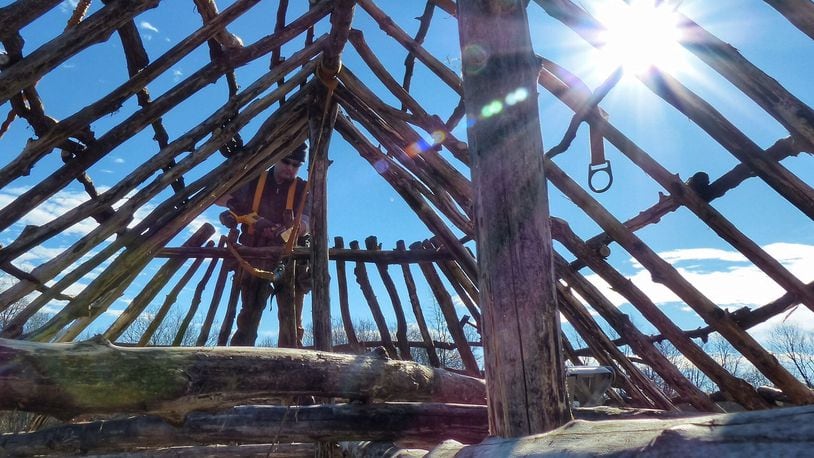2. What has been re-created? There are several wood and thatch huts constructed exactly where the originals used to be. A couple of these are dwellings where families lived. The Solstice House and the Big House served other purposes. The goal is someday to re-create the entire village.
3. How did the Solstice House get its name? In the center of the village are several poles. On the morning of the winter solstice, the shadow from the tallest pole enters the doorway of the Solstice House. So scientists believe this structure was used for ceremonies.
4. There's a structure called the Big House. What about it? This hut is next to the Solstice House, and the position of its doorway is also important. The shadow from the center pole enters the doorway of the Big House on April 29, and again on Aug. 14. Archaeologists have learned that those two times had agricultural significance. April 29 indicated the time to plant corn, and 110 days later, on Aug. 14, that corn crop would be ready to harvest. They used hoes made of mussel shells.
5. How important was corn to the Fort Ancient people? Very important! Archaeologists have learned that three-fourths of their calories came from eating corn.
6. What did the Fort Ancient people look like? They were small by today's standards. The men were about 5 feet, 3 inches tall. The women were 5-foot-1. Besides corn, squash and beans were important sources of nutrition, along with game, such as turkey, deer, elk and black bear.
7. Where did the Fort Ancient people come from? Their ancestors were the Hopewell, who lived in Ohio 2,000 years ago. The Hopewell were moundbuilders, and remains of some of their huge earthworks still exist today. The name "Hopewell" comes from Capt. Mordecai Hopewell, who owned the land in the 1890s that is now the Hopewell Mound Group outside Chillicothe, which is one of the nine sites that comprise the Hopewell Ceremonial Earthworks. In the coming years, these earthworks will be considered by the United Nations for the prestigious World Heritage List.
8. Is there anything special going on right now at SunWatch? Yes. Bill Kennedy, an archaeologist and the curator of Anthropology at the Dayton Society of Natural History, has been re-framing the roof of the Big House. In the next few weeks, he'll be joined by William Cahill, a master thatcher. Kennedy will assist Cahill in rethatching the roof with prairie grass they've collected.
9. How can I learn more? Visit SunWatch. In addition to the village, there's an Interpretive Center where excavated artifacts are on display. The park is at 2301 West River Road in south Dayton. It's very near the Great Miami River. Hours: Tuesday-Saturday, 9 am. - 5 p.m.; Sunday, 12 - 5 p.m.; closed Mondays. Admission: Adults, $6; seniors, $4; students, 6-16, $4; children under 6 and members are free. For more info: 937-268-8199 or sunwatch.org.
10. Are there any special programs? SunWatch is getting ready for its 2016 Archaeological Institute of America/SunWatch Winter Lecture Series: Archaeology in the Eastern U.S. All the lectures will be held on Saturdays at 10:30 a.m. Here's the lineup:
- • Jan. 16: "Resisting Removal: The Archaeology of an 1830's Appalachian Cherokee Farmstead" presented by Lance Greene, Ph.D., assistant professor of Anthropology at Wright State University.
- • Feb. 20: "Fort Ancient Ceramics in the Great Miami River Valley" presented by Jill Krieg-Accrocco, associate curator of Anthropology for the Dayton Society of Natural History.
- • March 19: "Early Human Populations in the New World: A Biased Perspective" by Archaeological Institute of American National Lecturer, James Adovasio, Ph.D.
- • April 16: “Buried Traces of Prison of War Communications with Loved Ones During the American Civil War” by Archaeological Institute of America National Lecturer, David Bush, Ph.D.
About the Author
